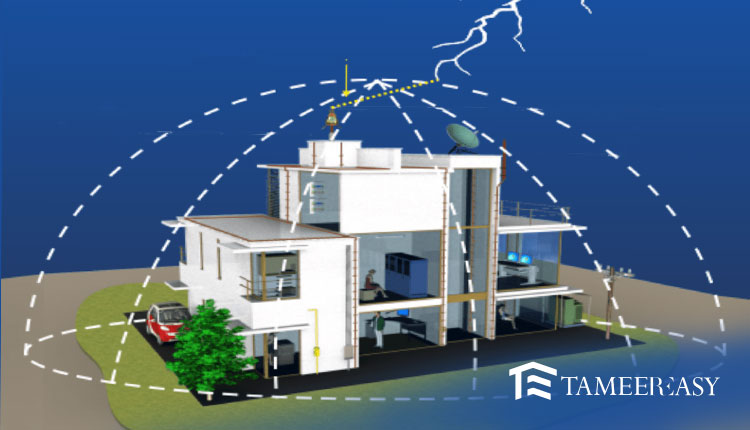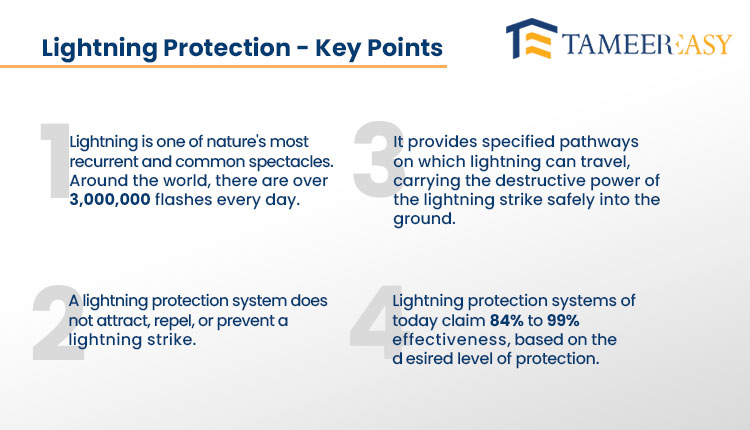Out of all the natural calamities faced by a building, lightning is one that is the most sudden and can have quite serious consequences. Besides damaging the electric appliances in homes and building structures, severe lightning can even lead to the loss of human life. But the good news is that we have a complete mechanism of lightning protection through which we can save our buildings, appliance and ourselves from any disaster.
Visit TameerEasy Store to Purchase Quality Construction Items
Through this article, we are going to tell you about the lightning protection system which you can install at your houses to ensure the safety of the building. First of all, you should learn the whole process and all the technicalities involved in it. To get all the updated and relevant information related to lightning protection system installation, just scroll down the page.

How Lightning is Generated and Why It Comes Down?
Lightning is generated due to the high density of clouds. In severe thunderstorms, dense clouds are produced which collide with each other to give rise to friction which ultimately results in producing charge. That charge remains disturbed and due to the imbalance between them, they take the form of light which ultimately finds the best way to travel downwards towards us. This is when we say that light has fallen someplace.
How to Stay Protected from Lightning
Lightning, on its way towards the earth’s surface, damages everything that comes in its path. Earth is the greatest insulator so the effects of lightning are stopped by installing something in its way which transfers the energy to the ground. Lightning Arresters are used for this purpose which provide a path for the light to get transferred to the surface easily without damaging anything in between.
Mechanism of Lightning Arresters
Lightning Arresters are the simple medium which provides a path for the energy to get grounded in the earth’s surface. In this way, the light does not blast anything; rather gets transferred to the surface and its effects get eradicated.
There are two types of lightning arresters for homes and buildings:
- Passive System
- Active System
Although both these types have the same function, they have different ways of grounding the light. Let’s discuss them separately so that you can understand them in the best way:
Passive Lightning Arrester System
In this system of lightning arresters, we install copper conductor rods at different places depending on the structure of the building. Once the system is installed at the appropriate places, then we have to ground these copper rods from different points. In this way, they catch the light coming all the way from clouds and ground it. It is quite a complex system and is used rarely in houses.
Active Lightning Arrester System
On the other hand, the active lightning arrester system is quite economical and works automatically. It has some sensors which activate the system in cloudy weather and it starts working. Its mechanism is quite simple that it spreads charge around it in a specific radius. In lightning conditions, these spread charges absorb the energy and transfer it to the ground, diminishing all the disastrous effects of light. The Active system is more feasible compared to the Passive system.


How to Install the System
The whole installation system is divided into three different stages:
Capture System: In the capture system, we install lightning arresters at the designated places advised by experts.
Down Conductor System: In this phase, we install the copper conductors which connect the arresters to the ground.
Earthing System: Here we ground the conductors through the copper rod so that it can effectively transmit the energy to the surface.
International Standards for Lightning Protection Systems
There are many international standards which are followed during Lightning Arrester installation.
NFC102: It is a French standard used for the Active system.
UNE21186: Spanish standard used for both Active and Passive systems.
ICE62305: It describes the complete design of the Passive lightning arrester system.
NFPA70: An American standard used for the Passive system.
Besides all these, there are a few local standards which are followed as per the situation of the weather and construction.
Key Point: Potohar and the Northern region of Pakistan are the areas which are highly vulnerable to lightning strikes. This is mainly due to environmental changes and constant cloudy weather.
Final Thoughts
So, through this article, we have explained the complete process of lightning and how you can save yourself and your house from its disastrous effects. By following all the methods explained above, you can eradicate the chances of lightning strikes on your building. If you still need any kind of guidance related to lightning, you can contact us through our website tameereasy.com.







